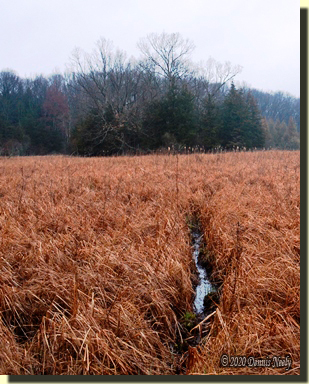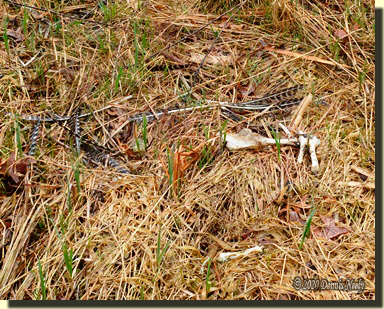Sparrows chirped. Cool mist tickled bare skin. A lone crow cawed beyond the hogback ridge. Silver orbs clung to the tips of drooping cedar boughs. Droplets scattered, dislodged by the incidental contact of short cautious steps. Two cardinals bantered, somewhere near the cedar grove.
Each footfall squished on the earthen doe trail. An occasional J-shaped wild turkey leaving added intrigue to the new and old hoof prints. The morning’s course wound around two spreading autumn olive bushes, skirted a broad red cedar tree, then ducked under the box elder with the table-sized scrape that always opened in late September.
Despite growing deafness, the glorious sounds of an awakening spring pumped exhilaration through a humble woodsman’s being. A dozen paces north of the box elder, green mouse ears dotted the barbed, curving stems of a big Rose of Sharron. Rotting deer pellets, a hint of urine and the damp bliss of stagnant swamp water perfumed that corner of Eden.
Dried prairie grass encompassed the base of the rose bush, then, lo and behold, a cottontail rabbit bounded from that miniscule haven. The gray streak bounded thrice uphill, stopping beside the first trunk of the second layer of cedar trees from the big swamp’s cut bank. The rabbit’s glossy eye assessed the circumstance. Feeble hearing detected a faint chorus of spring peepers. “…probably louder, but just can’t hear” the lead holder scribbled. A squish or two on the trail sent the bunny fleeing into oblivion.

Twenty paces past where the maple once grew that was blown to splinters by a lightning bolt four decades ago, the north half of the old hollow oak lay across the trail. A wood duck drake winged tree-top high by the south side of the closest island. A lone, black crow flew to the north, cawing away, but with no response.
To that point, the early morning scout produced no shed antlers, no gobbles, no bronze beauties—nary a cluck. Cautious footfalls turned the corner, then paused at the earthen delta washed who knows how many years ago into the swamp proper, leaving the large gully that is almost too steep to traverse.
Gurgling water beckoned the forest tenant to the east. The nameless creek flowed around several standing oaks, under moss-covered downed limbs, then snaked out into a thick patch of last-year’s brittle cattails.
To the west, a few dozen paces distant, a hint of white tweaked the wanderer’s curiosity. Scattered wing feathers, a half-chewed breast bone and a radius and ulna, still connected by wispy shreds of sinew, told a grim tale. As a knee touched the tender, greening grass, a gobble echoed up and down the big swamp.
“Gob-obl-obl-obl-obl-obl!”
A primary wing feather rolled back and forth between inquisitive fingers.
“Gob-obl-obl-obl-obl-obl!”
“Ah, near the hidden lake,” the woodsman thought, discerning that in all likelihood this was a young hen, caught and eaten just before the winter snows. The song birds’ twittering ceased, adding to the solemnity of the moment. Again on his feet, the woodsman turned back to the creek.
“Gob-obl-obl-obl! Obl-obl-obl-obl!”
The steep hillside taxed cabin-weary muscles. During a respite halfway to the crest, the lack of gobbling took on a haunting foreboding. “Perhaps those three calls were a requiem for the unfortunate hen?” he whispered. Such is the finality of the glade…
An Exhilarating Wild Turkey Scout
As I stood and gazed out over the swamp, the winding creek and the cattails, a gentle wind broke the morning calm. A deep breath, a sigh and a silent prayer of thanksgiving marked an appreciation at regaining a small portion of “what has been lost” over the last three years.
Even with bad hearing, the distant, rumbling whoosh of wind pressing hard on treetops was unmistakable. In the course of a long minute, the breeze gained strength. Barren oak, hickory and wild cherry tops swayed. Droplets angled earthward. Growing here and there amongst the hardwoods, the hill’s tall red cedar trees whispered, then groaned. The mist transformed into a steady drizzle, cleansing my soul and raising my spirits to a level they hadn’t reached in a long while.
A zig uphill, then a zag down brought this wilderness ragamuffin back to the deep ravine that gave up its sand and gravel to form the swamp delta. After a cautious crossing, the morning’s sojourn circled back to the point of beginning. I was late for work, but scribbling personal wilderness impressions is work, isn’t it?
Even with week-to-week or every-other-day jaunts, the forest hides its secrets well. Each time-traveling adventure holds a surprise or two, but for me, a long absence begins a period of re-acquaintance of sorts. It is during these scouts that I renew my connection to the land, my connection to the wilderness and my connection to long ago.

Spring rains and the accompanying mud kept me out of the woods the first week or two of shed antler hunting season. Now those trips combine with wild turkey scouts. Yes, I have found some sheds, and yes, I have heard and seen bronze beauties.
There are always discoveries, like a coyote-cleaned carcass of an eight-point buck, three red oaks and a wild cherry that came down over the winter and that pile of hen turkey feathers and bones, part-hidden to the west of the nameless creek. But there is freshness of life, too.
Remembrances of the Past
Likewise, there are always remembrances of past seasons, past decades. Some involve hunting exploits, near misses or natural occurrences. For example, noting the maple that was destroyed by lightning as a benchmark means nothing to anyone but me. I’ve told my daughters and wife the story of that tree, but I doubt any of them can take you to that location, let alone recount the tale.
The same goes for names of places scattered about my wilderness playground. The “Tamarac fen,” “Fred’s woods,” and “yellow tree” all carry meanings and a story or two. The names get passed on to fellow woodsmen, but the origin of the name is cloudy at best. Such was the case for many places in the 18th century. And to be fair about it, the meaning associated with some of those “passed down names” are debated to this day.
If it weren’t for a notation typed on a working map of the North-Forty, many locations would be anonymous, too. Newer names like “Darrel’s Tree,” “Tami’s Island” and “Katie’s Korner” are a case in point. In time these will slip off into oblivion, much like the “Duck Camp,” “Section Oak” and “Overlook Camp”—again, meaningless to all but a humble woodsman.
But herein resides “the connection to the land” that so many seek, but few find. Sunrises and sunsets, bald eagles and chickadees, poison ivy and wild mint all contribute to making each moccasin step a memorable experience. And after a long absence each new happenstance rejuvenates the passion and exhilaration that comes with being a tenant of the forest.
The stinging rain, the huffing wind, the gurgling water, the softness of sedge grass shoots, the smell of rotting deer pellets, and a tiny pile of bleached bones and tattered wing feathers left indelible impressions, but none as strong as the distant gobbles that sung the requiem for the unfortunate hen…
Wander back to the 18th century, be safe and may God bless you.


